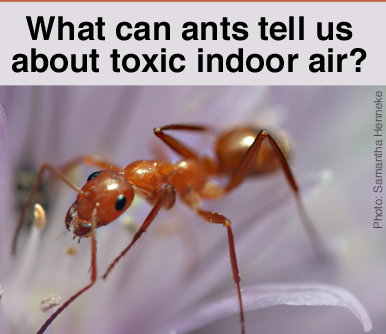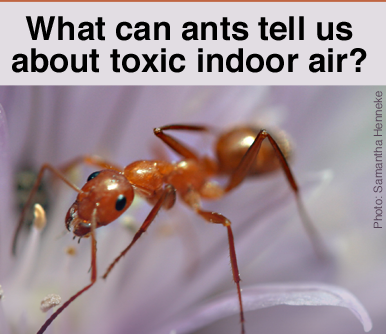 One of my personal heroes is E.O. Wilson, a well-respected biologist, author and researcher. He has spent a good part of his career studying ants (yes, ants!) and the behavoiors of “social insects.” Based on his research he argues that we should model human behaviors similar to social insects, who work to take care of the collective whole.
One of my personal heroes is E.O. Wilson, a well-respected biologist, author and researcher. He has spent a good part of his career studying ants (yes, ants!) and the behavoiors of “social insects.” Based on his research he argues that we should model human behaviors similar to social insects, who work to take care of the collective whole.
E.O. Wilson’s research about social insects can teach us a lot about the importance of working together and protecting our fragile ecosystems. There is fascinating new research on what ants can tell us about our daily exposures to toxic chemicals.
Learning from ants about hormone-disrupting chemicals
New research testing ants signals another reason for us to get serious about hormone-disrupting chemicals. Published this month in the journal Science of the Total Environment, Dr. Lenoir found that ants contain a class of toxic chemicals called phthalates.
[pullquote]The problem wasn’t simply that he found phthalates in the ants, but that he found them in all of the ants tested.[/pullquote] Even more interesting, the levels of phthalates increased in the ants overtime. So what caused this increase?
The boxes that the ants were being stored in were free of plastic and phthalates (which would have contributed to the ants exposure), so that wasn’t the reason. The researchers found that the ants were being exposed to phthalates in the
air, which contributed to the rise of phthalates tested.
What we can learn from this study
The implications for this study confirm and underscore two very important points. First, toxic chemicals like phthalates are ubiquitous – they’re everywhere. Since every ant tested positive for phthalates, there are serious implications for exposure levels in the human population.
Second, exposure to toxic chemicals from indoor air should not be dismissed. I know it’s sometimes hard to understand the complexities of our exposures to toxic chemicals through the air in our homes and workspaces. Most Americans spend more time indoors than they do outside – and depending on where you live, the indoor air quality can be more toxic than the air outside.
What are phthalates?
Phthalates are linked to lower testosterone levels, decreased sperm counts and poor sperm quality. Exposure to phthalates during development has been linked to malformations of the male reproductive tract and testicular cancer. Young children and developing fetuses are most at risk. Phthalates also have been associated with obesity, reduced female fertility, preterm birth and low birthweight, a worsening of allergy and asthma symptoms, and behavior changes.
What can we do?
Advocate for stronger laws. It’s time to get tough on toxic chemicals. Contact your Senators today and tell them we need serious action on hormone disrupting chemicals. Here’s how reform should addresses hormone-disrupting chemicals.
- It should require the EPA to consider endocrine disruption (hormone disruption) in their criteria for restricting or regulating a chemical.
- It should help us understand how we’re exposed to hormone disruptors through aggregate and cumulative (where possible) assessments.
- It should require information on chemical profiles, hazards and characteristics like hormone disruption that are currently kept secret under current law, further expanding the information we have about which chemicals act like hormones, where they are found and how we’re exposed.
- It should includes low-dose exposure as a criteria for assessing chemical safety.
Tips to reduce your exposure to phthalates
- Skip the fragrance when choosing cosmetics, personal care products, cleaning products, detergents, and air fresheners. (Skip the cologne or perfume too!) Manufacturers aren’t required to list phthalates on the label, but any item listed as “fragrance” is often a chemical mixture that can contain phthalates.
- Avoid buying plastics that may be treated with phthalates, including vinyl toys, shower curtains, and gloves. Look out for “PVC,” “V” or the “3” recycling code on the item or its packaging. For more information on PVC “the poison plastic” check out CHEJ’s website.
- Avoid phthalates in your children’s school. Here is a great guide of ways to avoid PVC plastic in your children’s school supplies and building.
- Clean up indoor air quality – Occasionally opening up windows and vacuuming with a HEPA filter are simple but effective ways to reduce indoor air pollutants. Plants are also a great way to clean up your indoor air. Some of the EPA’s highest ranked plants for filtering out toxics include: Mother in law’s tongue, peace lilies, golden pathos and many more. Organic Aspirations wrote a great blog on this topic if you’d like more information.
Ants are amazing creatures, they organize (like us!), build community, are social, and within a small amount of time they can cover a lot of ground. Let us learn from these little buggers and act on toxic chemicals! I’ll leave you with a quote from E.O. Wilson, “When you have seen one ant, one bird, one tree, you have not seen them all.”




